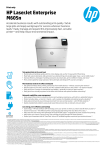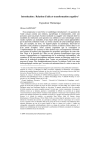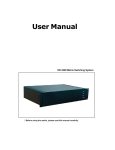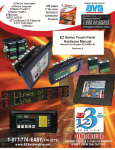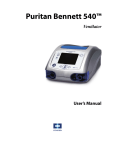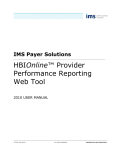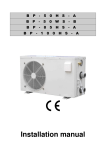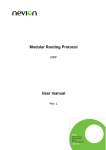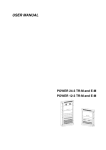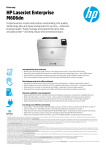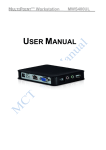Download Ami and Ami Plus
Transcript
Ami® and Ami® Plus Infant Central Apnea/Heart Rate Monitors Caregiver’s Manual 21-02-0117 Rev. 04 06/07 WARRANTY CAS Medical Systems, Inc. warrants to the owner that the Ami or Ami Plus monitor, exclusive of expendable parts and other accessories, shall be free from defects in material and workmanship for one year from the original date of sale. CAS’ sole obligation, with respect to any such defect, is limited to the repair or, at CAS’ option, replacement of the monitor. Purchaser pays return freight charges. This warranty is made on the condition that prompt notification of a defect is given to CAS within the warranty period, and that CAS has the sole right to determine whether a defect exists. This warranty is conditional on the performance of periodic maintenance, as specified in the maintenance section of this manual, by qualified service personnel. The warranty does not apply to monitors that have been partially or completely disassembled; altered; subjected to misuse, negligence, or accident; or operated other than in accordance with the instructions provided by CAS. This includes repair by unauthorized personnel. This warranty represents the exclusive obligation of CAS and the exclusive remedy of the purchaser regarding defects in the monitor. “This warranty is given in lieu of any express or implied warranties, including any warranty of merchantability or fitness for a particular purpose.” No person is authorized to modify, in any manner, CAS Medical Systems’ obligation as described above. Important: The Ami and Ami Plus User’s Manual has been renamed the Ami and Ami Plus Caregiver’s Manual. CAUTION: In the United States of America, Federal Law restricts this device to sale by or on the order of a physician. Ami, Ami Plus, CAS and the CAS Logo are registered trademarks of CAS Medical Systems, Inc. All other products and company names are trademarks or registered trademarks of their respective companies. ©2002 CAS Medical Systems, Inc. All rights reserved. No part of this manual may be reproduced without the permission of CAS Medical Systems, Inc. 21-02-0117 Rev. 04 06/07 Contents Warnings 1 Warnings . . . . . . . . . . . . . . . . . . . . . . . . . . . . . . 1-1 Introduction 2 Introduction . . . . . . . . . . . . . . . . . . . . . . . . . . . 2-1 Apnea Monitoring 3 Apnea Monitoring . . . . . . . . . . . . . . . . . . . . . . . 3-1 Electromagnetic Interference 4 Electromagnetic Interference . . . . . . . . . . . . . 4-1 Electrostatic Discharge . . . . . . . . . . . . . . . . . . . . . . . . . . . . . . . . . . 4-2 Description of the Monitor 5 Description of the Monitor . . . . . . . . . . . . . . . . 5-1 Front Panel . . . . . . . . . . . . . . . . . . . . . . . . . . . . . . . . . . . . . . . . . . . . 5-2 Back Panel . . . . . . . . . . . . . . . . . . . . . . . . . . . . . . . . . . . . . . . . . . . . . 5-3 Bottom Panel . . . . . . . . . . . . . . . . . . . . . . . . . . . . . . . . . . . . . . . . . . . 5-4 Labels . . . . . . . . . . . . . . . . . . . . . . . . . . . . . . . . . . . . . . . . . . . . . . . . . 5-5 Accessories 6 Accessories . . . . . . . . . . . . . . . . . . . . . . . . . . . 6-1 Carbon Electrodes . . . . . . . . . . . . . . . . . . . . . . . . . . . . . . . . . Lead Wires . . . . . . . . . . . . . . . . . . . . . . . . . . . . . . . . . . . . . . . Patient Cable . . . . . . . . . . . . . . . . . . . . . . . . . . . . . . . . . . . . . Patient Belt . . . . . . . . . . . . . . . . . . . . . . . . . . . . . . . . . . . . . . . 21-02-0117 Rev. 04 06/07 6-1 6-1 6-2 6-2 i Remote Alarm . . . . . . . . . . . . . . . . . . . . . . . . . . . . . . . . . . . . Power Cord . . . . . . . . . . . . . . . . . . . . . . . . . . . . . . . . . . . . . . Carrying Case . . . . . . . . . . . . . . . . . . . . . . . . . . . . . . . . . . . . Modem Cable . . . . . . . . . . . . . . . . . . . . . . . . . . . . . . . . . . . . . Oximeter . . . . . . . . . . . . . . . . . . . . . . . . . . . . . . . . . . . . . . . . Using the Monitor 6-3 6-3 6-4 6-4 6-4 7 Using the Monitor . . . . . . . . . . . . . . . . . . . . . . . 7-1 Plugging in the Monitor . . . . . . . . . . . . . . . . . . . . . . . . . . . . . . . . . . 7-1 System Check . . . . . . . . . . . . . . . . . . . . . . . . . . . . . . . . . . . . . . . . . . 7-2 Using the Monitor Effectively. . . . . . . . . . . . . . . . . . . . . . . . . . . . . . 7-2 Connecting The Monitor 8 Connecting The Monitor . . . . . . . . . . . . . . . . . 8-1 Auxiliary Connections 9 Auxiliary Connections . . . . . . . . . . . . . . . . . . . 9-1 Alarms 10 Alarms . . . . . . . . . . . . . . . . . . . . . . . . . . . . . . . 10-1 ii Human Alarms . . . . . . . . . . . . . . . . . . . . . . . . . . . . . . . . . . . . . . . . . Apnea . . . . . . . . . . . . . . . . . . . . . . . . . . . . . . . . . . . . . . . . . . Heart Fast. . . . . . . . . . . . . . . . . . . . . . . . . . . . . . . . . . . . . . . Heart Slow . . . . . . . . . . . . . . . . . . . . . . . . . . . . . . . . . . . . . . 10-1 10-1 10-1 10-2 Equipment Alarms. . . . . . . . . . . . . . . . . . . . . . . . . . . . . . . . . . . . . . Low Battery . . . . . . . . . . . . . . . . . . . . . . . . . . . . . . . . . . . . . Loose Leads. . . . . . . . . . . . . . . . . . . . . . . . . . . . . . . . . . . . . Memory Full . . . . . . . . . . . . . . . . . . . . . . . . . . . . . . . . . . . . . Service . . . . . . . . . . . . . . . . . . . . . . . . . . . . . . . . . . . . . . . . . All Lights Flashing . . . . . . . . . . . . . . . . . . . . . . . . . . . . . . . . 10-2 10-2 10-2 10-3 10-3 10-4 21-02-0117 Rev. 04 06/07 Troubleshooting and Error Messages 11 Troubleshooting . . . . . . . . . . . . . . . . . . . . . . . 11-1 Error Messages . . . . . . . . . . . . . . . . . . . . . . . . . . . . . . . . . . . . . . . . 11-4 Replace Battery . . . . . . . . . . . . . . . . . . . . . . . . . . . . . . . . . . 11-4 Loose Connection . . . . . . . . . . . . . . . . . . . . . . . . . . . . . . . . 11-4 Power 12 Power . . . . . . . . . . . . . . . . . . . . . . . . . . . . . . . . 12-1 Taking Care of Your Monitor 13 Taking Care of Your Monitor . . . . . . . . . . . . . 13-1 Maintenance 14 Maintenance . . . . . . . . . . . . . . . . . . . . . . . . . . 14-1 Summary 15 Summary . . . . . . . . . . . . . . . . . . . . . . . . . . . . . 15-1 Doctor’s Phone Number . . . . . . . . . . . . . . . . . . . . . . . . . . . . 15-1 Homecare Dealer’s Phone Number . . . . . . . . . . . . . . . . . . . 15-1 Glossary Index G-1 I-1 21-02-0117 Rev. 04 06/07 iii Figures Figure 5-1 Front Panel . . . . . . . . . . . . . . . . . . . . . . . . . . . . . . . . . . . . . . . . . . . . . 5-2 Figure 5-2 Back Panel . . . . . . . . . . . . . . . . . . . . . . . . . . . . . . . . . . . . . . . . . . . . . 5-3 Figure 5-3 Bottom Panel. . . . . . . . . . . . . . . . . . . . . . . . . . . . . . . . . . . . . . . . . . . . 5-4 Figure 5-4 Sample Label . . . . . . . . . . . . . . . . . . . . . . . . . . . . . . . . . . . . . . . . . . . 5-5 Figure 6-1 Carbon Electrodes . . . . . . . . . . . . . . . . . . . . . . . . . . . . . . . . . . . . . . . 6-1 Figure 6-2 Lead Wires . . . . . . . . . . . . . . . . . . . . . . . . . . . . . . . . . . . . . . . . . . . . . 6-2 Figure 6-3 Patient Cable. . . . . . . . . . . . . . . . . . . . . . . . . . . . . . . . . . . . . . . . . . . . 6-2 Figure 6-4 Patient Belt . . . . . . . . . . . . . . . . . . . . . . . . . . . . . . . . . . . . . . . . . . . . . 6-2 Figure 6-5 Remote Alarm . . . . . . . . . . . . . . . . . . . . . . . . . . . . . . . . . . . . . . . . . . . 6-3 Figure 6-6 Power Cord . . . . . . . . . . . . . . . . . . . . . . . . . . . . . . . . . . . . . . . . . . . . . 6-3 Figure 6-7 Carrying Case . . . . . . . . . . . . . . . . . . . . . . . . . . . . . . . . . . . . . . . . . . . 6-4 Figure 7-1 Connecting the Monitor to the Power Cord . . . . . . . . . . . . . . . . . . . . . 7-1 Figure 7-2 Connecting the Power Cord to the Wall Outlet . . . . . . . . . . . . . . . . . . 7-1 Figure 8-1 Rinse Electrodes . . . . . . . . . . . . . . . . . . . . . . . . . . . . . . . . . . . . . . . . . 8-1 Figure 8-2 Electrode with Lead wire . . . . . . . . . . . . . . . . . . . . . . . . . . . . . . . . . . . 8-2 Figure 8-3 Belt Placement . . . . . . . . . . . . . . . . . . . . . . . . . . . . . . . . . . . . . . . . . . 8-2 Figure 8-4 Electrode Placement . . . . . . . . . . . . . . . . . . . . . . . . . . . . . . . . . . . . . . 8-3 21-02-0117 Rev. 04 06/07 v Figure 8-5 Wrapped Belt . . . . . . . . . . . . . . . . . . . . . . . . . . . . . . . . . . . . . . . . . . . 8-4 Figure 8-6 Lead Wires and Patient Cable . . . . . . . . . . . . . . . . . . . . . . . . . . . . . . 8-4 Figure 8-7 Patient Cable and Monitor. . . . . . . . . . . . . . . . . . . . . . . . . . . . . . . . . . 8-5 Figure 8-8 Baby and Sleeper . . . . . . . . . . . . . . . . . . . . . . . . . . . . . . . . . . . . . . . . 8-5 Figure 8-9 Power . . . . . . . . . . . . . . . . . . . . . . . . . . . . . . . . . . . . . . . . . . . . . . . . . 8-6 Figure 8-10 Turning the Monitor Off . . . . . . . . . . . . . . . . . . . . . . . . . . . . . . . . . . . . 8-7 Figure 9-1 Auxiliary Connections . . . . . . . . . . . . . . . . . . . . . . . . . . . . . . . . . . . . . 9-1 vi 21-02-0117 Rev. 04 06/07 Tables Table 5-1 Description of Front Panel. . . . . . . . . . . . . . . . . . . . . . . . . . . . . . . . . . 5-2 Table 5-2 Description of Back Panel . . . . . . . . . . . . . . . . . . . . . . . . . . . . . . . . . . 5-3 Table 5-3 Description of Bottom Panel . . . . . . . . . . . . . . . . . . . . . . . . . . . . . . . . 5-4 Table 5-4 Description of Label . . . . . . . . . . . . . . . . . . . . . . . . . . . . . . . . . . . . . . 5-6 Table 9-1 Description of Auxiliary Connections. . . . . . . . . . . . . . . . . . . . . . . . . . 9-1 21-02-0117 Rev. 04 06/07 vii Section 1 Warnings1 21-02-0117 Rev. 04 06/07 Warnings Warnings The following warnings appear throughout this manual. For more information on a specific warning, see the section referenced in the warning. WARNING The monitor may not be able to detect all episodes of inadequate breathing. Refer to Section 3. WARNING Caregivers must closely watch patients who are subject to obstructive apnea. Refer to Section 3. WARNING Federal Law restricts this device to sale or use by or on the order of a licensed physician. Refer to Section 3. WARNING Not to be used in an explosive atmosphere. Refer to Section 3. WARNING The monitor may sometimes detect false breathing signals called artifacts. Refer to Section 3. WARNING Children at risk of seizures need to be closely watched to protect them from obstructive apnea during a seizure. Ask your physician for specific instructions on what to do if your child has a seizure. Refer to Section 3. 21-02-0117 Rev. 04 06/07 1-1 Warnings WARNING The Ami and Ami Plus monitors may be affected by electromagnetic interference from household appliances, for example static from a television set. This interference may keep the monitor from working properly. Refer to Section 4. WARNING If at any point the monitor alarm is not loud enough to get your attention, do not leave your child unattended. Refer to Section 7. WARNING All directions in the Connecting The Monitor section must be followed carefully. Refer to Section 8. WARNING To reduce the risk of strangulation, do not leave loose or unconnected wires in the infant’s crib. Make sure that wires are routed away from the child’s head. Refer to Section 8. WARNING During an equipment alarm (except Low Battery Caution) the monitor cannot sound any human alarms because of the equipment problem. Therefore, during an equipment alarm (except Low Battery Caution) someone must watch the patient until the equipment problem has been corrected. Refer to Section 8. WARNING If the monitor’s modem is in use, the monitor must be disconnected from the phone lines before you can use the phone. Refer to Section 9. 1-2 21-02-0117 Rev. 04 06/07 Warnings WARNING When the monitor is not working someone must watch the child at all times. Refer to Section 10. WARNING If detergent is not fully rinsed out of the electrode belt, the patient may get a skin rash. Refer to Section 13. 21-02-0117 Rev. 04 06/07 1-3 Section 2 Introduction2 21-02-0117 Rev. 04 06/07 Introduction Introduction This book explains what apnea is and how the Ami and Ami Plus monitors detect it. It also explains how to setup the monitor, respond to monitor alarms, and care for the monitor. It is important that you read and understand all of the information in this book. It is important that you also share this information with anyone who will care for your child. This book: • Explains what apnea is and how the monitor detects it. • Describes the monitor and its features. • Shows how to connect the monitor to your child. • Discusses how to respond to monitor alarms. • Explains how to care for the monitor and what to do if you have a problem with the monitor. If you have questions or problems with the monitor that are not answered in this book, ask your doctor or homecare dealer for help. Follow directions given to you by your doctor or homecare dealer. In this manual, the following conventions are used. WARNING Directions that warn of conditions that put the baby or caregiver at risk. CAUTION Directions that help you avoid damaging your monitor or losing data. Note: Directions that make it easier to use your monitor. 21-02-0117 Rev. 04 06/07 2-1 Section 3 Apnea Monitoring3 21-02-0117 Rev. 04 06/07 Apnea Monitoring Apnea Monitoring Apnea is a medical term meaning a time when a person stops breathing. Central apnea occurs when a person does not make an effort to breath. Your doctor has prescribed this monitor to help protect your child from the dangers of an apnea event. All babies experience short, harmless periods of apnea. Some babies, especially premature ones, have longer periods that can be harmful. Your doctor has probably spoken to you about the monitor and how it may help your child. The monitor, when used according to its directions, is intended to alert you when your child experiences central apnea. It is very important that you immediately respond to all of the monitor’s alarms. Everyone caring for the child must know how to respond to the monitor’s alarms. Everyone caring for the child must know CPR (Cardiopulmonary Resuscitation) for infants. If you have not received CPR training, ask your doctor or homecare dealer about how to get certified training. The Ami and Ami Plus monitors are intended to detect central apnea through a process called impedance monitoring. As your child’s chest expands and contracts during breathing, the chest’s movement causes a change in the signal between the electrodes which the monitor senses. When central apnea happens, the child stops breathing and the chest does not expand or contract. When the monitor detects that the chest is not moving, the alarm sounds. The monitor does not interfere with your child’s breathing. WARNING The monitor may not be able to detect all episodes of inadequate breathing. The Ami and Ami Plus monitors also detect your child’s heart rate with the same electrodes used to detect breathing. A heart rate alarm will sound when the heart rate is outside the set alarm limits. A heart rate alarm may sound when inadequate breathing occurs. WARNING Caregivers must closely watch patients who are subject to obstructive apnea. Obstructive apnea is when the child tries to breathe, but the air does not reach the lungs, due to a blockage in the airway. The blockage can be caused by soft tissues in the child’s throat blocking the trachea or windpipe. If the child has a cold, tonsillitis, enlarged adenoids, or other respiratory 21-02-0117 Rev. 04 06/07 3-1 Apnea Monitoring problems, blockage from soft tissue can occur. The Ami and Ami Plus monitors are not intended to detect obstructive apnea. A child’s chest can still expand and contract even when the airway is blocked. The Apnea alarm may not sound because it may still detect false breathing signals. If this occurs, a Heart Slow alarm may sound since the child’s heart rate will drop. Children who suffer from these respiratory problems must be watched closely to protect them from obstructive apnea. WARNING Federal Law restricts this device to sale or use by or on the order of a licensed physician. WARNING Not to be used in an explosive atmosphere. Do not allow any person or pets to sleep with a monitored child. Movements by people or by pets may cause your child to move. The monitor may interpret this movement as breathing from your child and may not alarm properly. CAUTION Do not rely on the monitor while the child is subject to being jostled (use of baby swing, car travel over rough roads, etc.). This type of motion may prevent any impedance monitor from properly detecting breathing or heart rate. WARNING The monitor may sometimes detect false breathing signals called artifact. An apnea alarm may be delayed, or not occur at all, if the child stops breathing but the monitor detects false breathing signals. If this happens a Heart Slow alarm will sound if your child’s heart rate drops. WARNING Children at risk of seizures need to be closely watched to protect them from obstructive apnea during a seizure. Ask your physician for specific instructions on what to do if your child has a seizure. 3-2 21-02-0117 Rev. 04 06/07 Section 4 Electromagnetic Interference 21-02-0117 Rev. 04 06/07 4 Electromagnetic Interference Electromagnetic Interference WARNING The Ami and Ami Plus monitors may be affected by electromagnetic interference (EMI) from household appliances, for example, static from a television set. This interference may keep the monitor from working properly. The monitor is an electronic device. Electronic devices can be affected by electrical interference from household appliances. Loose electrodes can cause electromagnetic interference. Although interference is unlikely, no device is completely immune. The monitor was tested and conforms to industry guidelines. The monitor should not be operated near: • television sets • citizens band and amateur radios • microwave ovens • paging transmitters • radio/TV station transmitters • emergency vehicle two way radios • air conditioners • radio-controlled toys • hand-held transceivers (i.e. walkie-talkies, security, emergency) • Electronic Article Surveillance (EAS) (found in many stores as security devices) • cordless or cellular telephones • food processors • wireless computer links communications/data transmitters • other Ami or Ami Plus monitors (4 ft. minimum separation) Using the monitor near these appliances may cause the monitor to fail to alarm. To prevent this, move the appliance as far away as possible from the monitor. Watch the Respiration and Heartbeat lights on the monitor. Compare with baby’s breathing and pulse. If they do not match, it may be due to electromagnetic interference. Carefully watch the child and call the homecare dealer for assistance. 21-02-0117 Rev. 04 06/07 4-1 Electromagnetic Interference The monitor should not share electrical outlets with any of these appliances. This may cause electrical interference with the monitor and cause the monitor to fail to alarm. Electrostatic Discharge 4-2 Electrostatic Discharge (ESD) is the small electric shock caused by static electricity. ESD happens when you touch an object, like the monitor, after walking across a carpeted floor when the weather is cool and dry. Touching a wall or the crib before handling the monitored child or the Ami Monitor can prevent this. Whenever possible, use cotton bed sheets for the baby and a fabric softener in the laundry. The use of a spray Static Guard in carpeted floor areas can help the minimize this type of interference. 21-02-0117 Rev. 04 06/07 Section 5 Description of the Monitor5 21-02-0117 Rev. 04 06/07 Description of the Monitor Description of the Monitor The Ami and Ami Plus monitors are meant to be used in the home, in a hospital, or on family outings. Your doctor should have told you when to use the monitor. If you are unsure when to use the monitor, use it all the time (except when bathing your child), but ask your doctor for more specific directions. The outlet for the patient cable is on the monitor’s front panel. There are two buttons on the front panel of the monitor. These buttons are marked Reset and Power. The front panel of the monitor also has warning lights and other indicators of the monitor’s operating status. When lit, green lights show that the monitor is properly connected and that it is detecting breathing and heartbeats. Red lights show an alarm condition or an equipment problem. These red lights tell you why an alarm sounds. There are ten lights on the front of the monitor. • • APNEA — Red light shows that there has been an episode of central apnea. HEART FAST — Red light shows that the heart is beating faster than the set limits. • HEART SLOW — Red light shows that the heart is beating slower than • LOOSE LEAD — Red light shows that a wire, electrode, belt, or patient cable is loose or disconnected. • SERVICE — Red light shows that the monitor is in need of servicing by a licensed provider. • LOW BATTERY — A constant red light shows that there is not enough • MEMORY FULL — The monitor’s memory stores information that will • • the set limits. power to properly operate the monitor. A flashing light shows that the monitor has enough battery power to operate properly for at least 60 minutes. be used by your doctor. A constant red light shows that this memory is full. A flashing light shows that data has been lost. Call your homecare dealer if this light comes on. RESPIRATION — Green light shows that the monitor is detecting breathing. HEARTBEAT — Green light shows that the monitor is detecting a heartbeat. 21-02-0117 Rev. 04 06/07 5-1 Description of the Monitor • CHARGING — Green light shows that power is being supplied from an AC outlet and the battery is being charged. Front Panel Figure 5-1 Front Panel A H B C D E F G Table 5-1 Description of Front Panel 5-2 A Audible alarm output. Do not put anything in front of this opening. B Respiration and Heartbeat lights. Green lights blink once with each detected breath or heartbeat. C Human Alarm lights. Red lights come on when the monitor detects breathing effort or heart rate outside the alarm limits set by your doctor. D Charging light. The green Charging light shows that power is being supplied from an AC outlet and the battery is charging. E RESET Button. Use to turn off alarm lights after the problem is corrected. Also use with the Power button to turn the monitor off. F POWER Button. Use to turn the monitor on. G Patient Connector. Use to connect the monitor to the patient cable. H Equipment Alarm lights. Indicate an equipment alarm event. 21-02-0117 Rev. 04 06/07 Description of the Monitor Back Panel Figure 5-2 Back Panel A C B D E F G Table 5-2 Description of Back Panel A Audible alarm output. Do not put anything in front of this opening. B Battery compartment. C Remote alarm output. D Interface connector (RS-232). E Telephone connector. F Fuse holder. G Power cord connector. 21-02-0117 Rev. 04 06/07 5-3 Description of the Monitor Bottom Panel Figure 5-3 Bottom Panel A B C D Table 5-3 Description of Bottom Panel A Message display. B ENTER button. C Up and down arrow keys. D MODE button. The bottom panel of the monitor has a message display and control panel. The control panel has four buttons that are used by your dealer to enter information. If your dealer instructs you to use the control panel buttons, follow instructions carefully. 5-4 21-02-0117 Rev. 04 06/07 Description of the Monitor Labels Each monitor includes labels explaining the monitor’s features and information needed to operate this device safely. A sample label is shown below. Figure 5-4 Sample Label A B C D E F G H I J K L 21-02-0117 Rev. 04 06/07 5-5 Description of the Monitor Table 5-4 Description of Label 5-6 A Attention: It is important that you read and understand all of the information in this manual along with any other documentation that came with the monitor. B The monitor meets the IEC 601- 1 standard (an international safety standard) for Type BF Equipment. Type BF Equipment is constructed so the patient is protected from hazardous electrical currents. C The monitor is enclosed in a case to protect against dripping water. D Unprotected lead wires and cables should not be used with this device. Inappropriate electrical connections may pose an unreasonable risk of adverse health consequences or death. E Not to be used in an explosive atmosphere, for example, where a high amount of oxygen or flammable gas is present. F The monitor may be subject to electrical interference if used near certain household appliances. Refer to Section 4 for more information. G The caregiver must read and understand the entire Caregiver’s Manual before using the monitor. The caregiver must share this information with anyone who will care for the child. H Only accessories provided by your homecare dealer may be used with the monitor. Using other accessories may cause the monitor to not work properly. Refer to Section 6 for more information. I The monitor may not alarm properly if cautionary information and instructions are not followed. Refer to Section 10 for more information. J Do not connect the monitor to an electrical outlet controlled by a switch. K US Federal law restricts the sale or use of the Ami and Ami Plus monitors without a prescription from a licensed physician. L Read the instruction manual and all documentation before operating the monitor. 21-02-0117 Rev. 04 06/07 Section 6 Accessories6 21-02-0117 Rev. 04 06/07 Accessories Accessories The accessories for the Ami and Ami Plus monitors include: electrodes, patient belt, lead wires, patient cable, power cord, remote alarm, modem, modem cable, oximeter, direct connect cables and a carrying case. The following accessories are needed to use the monitor: Carbon Electrodes • Electrodes • Lead Wires • Patient Cable • Patient Belt • Power Cord The black electrode pads pick up the breathing effort and heartbeat signals from the baby. Rinse the flat sides of the pads with water each day. Do not use soap or detergent on the pads because both interfere with breath and heart beat signals. Your homecare dealer may give you other types of electrodes. Your homecare dealer will instruct you in their proper application. It is important that any type of pre-gelled electrodes are used before the manufacturer’s expiration date. Before the electrodes are used, check to see if they have become dried-out or damaged during storage. Dried-out or damaged electrodes may not properly detect the baby’s breathing effort and heartbeat and may prevent an alarm from being detected. Figure 6-1 Carbon Electrodes Lead Wires The lead wires carry the breathing effort and heartbeat signals from the electrodes to the patient cable. Always hold the lead wires by the plastic ends when you are connecting or disconnecting them. Never pull on the lead wires cord because you can damage the wires inside the leads. 21-02-0117 Rev. 04 06/07 6-1 Accessories Figure 6-2 New lead wires come joined together. When you connect the child to the monitor, pull gently to separate the leads as much as you need to. Lead Wires Patient Cable The patient cable carries the breathing effort and heartbeat signals from the lead wires to the monitor. Hold the patient cable at the ends when you are connecting or disconnecting. Never pull on the cable’s cord because you may damage the wires inside. Figure 6-3 Patient Cable Patient Belt The belt is made of soft foam and is used to hold the electrodes to the infant’s chest. The belt is fastened around the infant’s chest with a velcro strip. Figure 6-4 Patient Belt 6-2 21-02-0117 Rev. 04 06/07 Accessories Remote Alarm The remote alarm allows monitoring up to 100 feet from your baby. The remote alarm will sound anytime the monitor alarms. The Alarm light will also come on. The alarm will sound if the monitor becomes disconnected from the remote alarm or if the monitor’s Power button is pressed without pressing the Reset button first. Figure 6-5 Remote Alarm Power Cord A standard AC power cord which connects the monitor to an electrical outlet. Figure 6-6 Power Cord 21-02-0117 Rev. 04 06/07 6-3 Accessories Carrying Case This case holds the monitor, patient cables and electrodes when you need to take the baby and monitor out of the home. Figure 6-7 Carrying Case Modem Cable The modem is a standard feature of the Ami Plus monitors. It sends information from the monitor, through telephone lines, to a computer at another location. If the monitor has a modem there will be a label reading “Modem” on the back of the monitor, below the modem jack. The modem cable connects the monitor to a phone jack to transmit information from the monitor to an outside source. Oximeter The oximeter is a separate device that can be used with the Ami or Ami Plus monitors to record oxygen saturation levels in the blood, and pulse rate. If an oximeter is used with the monitor, your homecare dealer will instruct you on how to properly use the oximeter. The monitor does not alarm for oxygen saturation; the oximeter may alarm for low oxygen saturation. 6-4 21-02-0117 Rev. 04 06/07 Section 7 Using the Monitor7 21-02-0117 Rev. 04 06/07 Using the Monitor Using the Monitor Plugging in the Monitor Plug the socket end of the power cord into the power cord connector on the back of the monitor. Plug the other end of the cord into a wall outlet. If the integrity of the earth ground connection is in doubt, the monitor should be operated on battery power. The Charging light will only illuminate when the monitor is plugged in. If the monitor is plugged in and the Charging light is not on, check the connection to both the monitor and the electrical outlet. If the light does not come on, call your homecare dealer. Note: Keep the monitor plugged in whenever possible. Figure 7-1 Connecting the Monitor to the Power Cord Figure 7-2 Connecting the Power Cord to the Wall Outlet 21-02-0117 Rev. 04 06/07 7-1 Using the Monitor System Check When the Ami or Ami Plus monitor is first turned on it runs through a system check to make sure the monitor is working properly. During this check the monitor’s alarm will beep and all the monitor’s lights, except the Charging light, will flash individually. The Charging light will not flash during the system check. If you do not hear the monitor’s alarm beep, turn the monitor off and repeat the system check. If you do not hear the alarm beep, call your homecare dealer for further assistance. When the system check is over, look to see if an alarm light is on. If so, follow the instructions in Section 10 to fix the problem. Note: The monitor should be turned off and on daily so that it can run through the system check. It is best to do this when the baby is awake. The monitor should always be used when the baby is sleeping or according to instructions from your physician. Using the Monitor Effectively The Ami and Ami Plus monitors are effective only if the alarms can be heard. Before connecting the monitor to your child, you need to test how well the alarms can be heard in every location of the home. 1. Put the monitor where it will be used most. 2. Plug the monitor into a wall outlet. Do not connect the monitor to the baby. 3. Turn the monitor on. All lights will illuminate as the monitor runs through a system check. A Loose Lead alarm will sound. 4. Go to each part of the home and see if you can hear the alarm. Try to do the things you will normally do. If you will be running water, turn on the water. If the TV will be on, turn on the TV. If you will be vacuuming, turn on the vacuum. WARNING If at any point during this test the monitor is not loud enough to get your attention, do not leave your child unattended while you are in this room. A remote alarm for the Ami and Ami Plus monitors is available. This alarm allows you to hear the monitor alarms from farther away. If you think the remote alarm is necessary, one can be obtained from your homecare dealer. If you are using a remote alarm, repeat the test above using the remote alarm so it can be placed in the best position. You must make sure that you can respond to an event immediately after its first alarm. It is especially important to consider this when using the remote alarm. 7-2 21-02-0117 Rev. 04 06/07 Section 8 Connecting The Monitor8 21-02-0117 Rev. 04 06/07 Connecting The Monitor Connecting The Monitor This section will discuss how to set up the Ami and Ami Plus monitoring systems. It is very important that all information in this section is read and understood. WARNING All directions in this section must be followed carefully. Note: Use only soap and water to clean the child’s skin where the electrodes will be placed. The skin must be free of lotion and powders. If the child’s skin is not clean in this area, the monitor may not operate properly. Use of electrodes may result in an allergic or chemical reaction with your child’s skin. If redness or skin irritation is noticed, contact your home care provider. Periodic placement of the electrodes in different locations may prevent or reduce the occurrence of skin irritation. 1. Rub the flat side of the electrodes under warm, running water for at least one minute. Dry the electrodes before using them. Figure 8-1 Rinse Electrodes 21-02-0117 Rev. 04 06/07 8-1 Connecting The Monitor 2. Connect the electrodes to the lead wires. Plug the metal tips of the lead wires into the electrodes. Be sure you push the lead wire tips in all the way. Figure 8-2 Electrode with Lead wire 3. Lay the belt on a flat surface. Lay the child down with the child’s back on the belt. It is important to place the electrodes correctly. The best place is in line with each armpit, near the bottom rib, as shown in Figure 8-4. If you must place them somewhere else, make certain they are on the child’s rib cage, on opposite sides of the chest. If you imagine a line going from one electrode to the other, that line must seem to go through the center of the child’s chest. Figure 8-3 Belt Placement 8-2 21-02-0117 Rev. 04 06/07 Connecting The Monitor 4. Place the electrodes on the belt with the Velcro side down. Lay the electrode pads on the belt so that when the belt is wrapped around the child, the pads will be in the correct place. Place the pad with the white end on the child’s right. Place the pad with the black end on the child’s left. The pads should be in line with the armpit and down toward the bottom rib. Separate the wires as much as needed. CAUTION If the electrodes are touching each other, an improper signal will be sent to the monitor. Figure 8-4 Electrode Placement White Lead 21-02-0117 Rev. 04 06/07 Black Lead 8-3 Connecting The Monitor 5. Wrap the belt snugly but not tightly around the patient’s chest. Close the belt and fasten it with the velcro strip. The belt needs to be snug but not too tight. It should be possible to slide one finger under the belt after it is closed. Be sure that the belt does not overlap and block one of the electrodes. If necessary remove the belt, then cut it to make it shorter. Figure 8-5 Wrapped Belt 6. If an oximeter is being used, your homecare dealer will tell you how to place the oximeter sensor. 7. Connect the lead wires to the patient cable. The white connector on the lead wire goes into the hole with the white mark on the patient cable. The black connector goes into the hole with the black mark. Push the connectors until they snap firmly into the cable. These connections fit tightly. Figure 8-6 Lead Wires and Patient Cable 8-4 21-02-0117 Rev. 04 06/07 Connecting The Monitor 8. Connect the patient cable to the monitor. Plug the patient cable into the patient cable jack on the front of the monitor. Be sure it is firmly in place. The cable slips in only if you have the button on the end of the cable facing up. To remove the cable from the monitor, press the button at the end of the cable and pull straight out. Figure 8-7 Patient Cable and Monitor Be sure the lead wires and patient cable are away from the child’s head and neck. You can put a sleeper over the cable and lead wires, with the patient cable coming out near your child’s foot, as shown in Figure 8-8. Or, you can tape the cable to your child’s ankle; your doctor or homecare dealer have a special tape that will not harm your child’s skin. WARNING To reduce the risk of strangulation, do not leave loose or unconnected wires in the infant’s crib. Make sure that wires are routed away from the child’s head. Figure 8-8 Baby and Sleeper 21-02-0117 Rev. 04 06/07 8-5 Connecting The Monitor 9. Turn monitor on by pressing the power button. Figure 8-9 Power All lights, except the Charging light, will illuminate as the monitor runs through a system check. When the system check is over, make sure the green indicator lights are blinking, showing that the electrodes are firmly connected and the monitor is receiving signals. If the electrodes are not firmly connected, the indicator marked Loose Lead will light up and an audible alarm will sound. If you have been instructed to use the Signal Quality indicator, turn the monitor over and check the quality rating. The connection rating describes the quality of the belt, electrodes, lead wires, and patient cable connections. The signal rating describes the quality of the respiration effort and heart rate signals. If the rating is Best or Good the signal and connection qualities are acceptable. If the rating is poor, you may be instructed to follow the Signal Quality instructions in the Section 11 to reduce the potential for false alarms. WARNING During an equipment alarm (except Low Battery caution) the monitor cannot sound any human alarms because of the equipment problem. Therefore, during an equipment alarm (except Low Battery caution) someone must watch the patient until the equipment problem has been corrected. 8-6 21-02-0117 Rev. 04 06/07 Connecting The Monitor To turn the monitor off, press and hold the RESET button, then press the POWER button at the same time. After a delay of up to 30 seconds, the monitor will signal that it has powered down with an audible double beep. After the beep, the monitor may be turned on again. Figure 8-10 Turning the Monitor Off 21-02-0117 Rev. 04 06/07 8-7 Section 9 Auxiliary Connections9 21-02-0117 Rev. 04 06/07 Auxiliary Connections Auxiliary Connections Figure 9-1 Auxiliary Connections A B C Table 9-1 Description of Auxiliary Connections A REMOTE ALARM — Plug the small end of the remote alarm cable into the remote alarm output jack. B AUXILIARY INPUTS/ DATA OUTPUT — Plug the monitor end of the cable into the interface connector. C MODEM — The modem cable is plugged into the monitor’s telephone connector like a telephone cord. Insert the cable with the tab facing down until you feel it click. The other end of the cable is plugged into your telephone outlet. Note: The internal modem always answers phone calls on the first ring. Therefore, only connect the modem cable when instructed by your doctor or homecare dealer, or when you expect the monitor to send or receive data. To unplug the modem cable, press the tab and pull out. WARNING When the monitor’s modem is in use, the monitor must be disconnected from the phone lines before you can use the phone. 21-02-0117 Rev. 04 06/07 9-1 Auxiliary Connections CAUTION When monitoring a patient, make sure AC power is connected to the monitor whenever the phone line is connected to the monitor via a modem. When you are monitoring a patient and the monitor is connected via modem to the phone lines, the monitor may not accurately detect heartbeats when the phone rings and the AC power cord is not connected to the monitor. Without AC power during use with a modem, the monitor may detect an extra heartbeat or miss a heartbeat during each ring. 9-2 21-02-0117 Rev. 04 06/07 Section 10 Alarms10 21-02-0117 Rev. 04 06/07 Alarms Alarms The monitor will sound an alarm when it detects a problem with your child’s breathing or heart rate, or with the equipment. You must respond to all alarms at once. Your child needs careful and prompt care when an alarm sounds. The monitor warns you of a problem, but you must correct the problem. All caregivers of a monitored child must receive CPR (Cardiopulmonary Resuscitation) training for infants. If you or any other caregiver has not received this training, you must contact your doctor or home health care provider as soon as possible to receive this training. The monitor will sound an alarm for two reasons. When the monitor detects a problem with the child’s breathing or heart rate, it will signal a human alarm. When the monitor detects a problem with the equipment, it will signal an equipment alarm. You must make sure that you can respond to an event immediately after its first alarm. It is especially important to consider this when using the remote alarm. The first thing to remember when answering an alarm is to always check the child first. Human Alarms Human alarms warn you that the monitor has detected apnea, fast heart rate, or a slow heart rate. For human alarms, you must respond as you have been trained. Your doctor and homecare dealer can help you get the proper training. Apnea An Apnea alarm tells you that the monitor did not detect suitable breathing from your child. If your child is not breathing, follow your doctor’s instructions. When the monitor detects suitable breathing, the alarm sound will stop. The red Apnea light will stay on until you press the RESET button. Heart Fast A Heart Fast alarm tells you that your child’s heart is beating faster than the high heart rate alarm limit. If this alarm sounds, follow your doctor’s instructions. When the heart rate comes down below the alarm limit, the alarm sound will stop. The red Heart Fast light will stay on until you press the RESET button. 21-02-0117 Rev. 04 06/07 10 - 1 Alarms Heart Slow A Heart Slow alarm tells you that your child’s heart is beating slower than the low heart rate alarm limit. If this alarm sounds, follow your doctor’s instructions. When the heart rate is above the alarm limit, the alarm sound will stop. The red Heart Slow light will stay on until you press the RESET button. Equipment Alarms Equipment alarms warn you of possible problems with the equipment. Most equipment alarms produce a continuous audible alarm for the duration of the event. The first thing to remember when answering an alarm, is to always check the child first. If the alarm is from an equipment problem, check the front display to see why the monitor’s alarm is sounding. Low Battery The red Low Battery light is constantly lit and the audible alarm beeps twice each second when the battery does not have enough power for the monitor to work properly. The red Low Battery light flashes when battery power is low but the monitor will still work properly. • To correct a Low Battery alarm, plug the monitor into an AC electrical outlet. • The green Charging light should light. If the monitor is plugged in at all times, the monitor should not indicate Low Battery alarms. If the monitor is plugged into a wall outlet and power is lost, the monitor can operate up to 20 hours if the monitor’s battery is fully charged. Loose Leads A Loose Lead alarm will sound constantly if there is a poor or loose connection between the child and the monitor. If you have a Loose Lead alarm, do the following: Check the lead wire and patient cable connections to be sure they are tight. 10 - 2 • Electrodes to lead wires, • Lead wires to patient cable, and • Patient cable to patient cable jack. 21-02-0117 Rev. 04 06/07 Alarms Check the electrodes. • Are they in the right place? • Is the belt snug enough? • Are the electrodes clean? They should not have any lotion, powder or oil on them. • Try new electrodes. Check the lead wires. • Are they tightly connected to the electrodes and patient cable? • Try a new set of lead wires. Check the patient cable. • Is the patient cable tightly connected to the monitor? • Try a new patient cable. If these steps do not work, call your homecare dealer immediately for assistance. When the problem is corrected, the monitor will turn the alarm off but the Loose Lead light will stay on until the RESET button is pressed. Memory Full The monitor will light a red Memory Full light when its memory is almost full. The audible alarm will not sound. If you have a Memory Full alarm: Service • Follow the instructions your doctor or homecare dealer gave you, or • Call your doctor or homecare dealer for instructions. A Service alarm warns you of a problem with the monitor. To fix a service alarm: • Hold in the RESET button and turn the monitor off. • Make sure nothing is blocking the audible alarms. • Wait 30 seconds. The monitor will sound a double beep. • Turn the monitor back on again. If the problem is corrected, no alarm will sound. If the alarm problem is not corrected, the service alarm will sound again. If this happens, do not use the monitor. Turn the monitor off and call your homecare dealer immediately. A caregiver should personally monitor the child. 21-02-0117 Rev. 04 06/07 10 - 3 Alarms All Lights Flashing All lights will flash if both audio alarms are not working. If this happens, do not use the monitor. Turn the monitor off and call your homecare dealer immediately. WARNING When the monitor is not working someone must watch the child at all times. If you cannot fix the equipment problem, consult your homecare dealer or your physician. Always remember to watch your child closely during an equipment problem. 10 - 4 21-02-0117 Rev. 04 06/07 Section 11 Troubleshooting and Error Messages 11 21-02-0117 Rev. 04 06/07 Troubleshooting and Error Messages Troubleshooting FALSE APNEA ALARM If you have a problem with a false alarm, or other monitor alarm, and need assistance, this troubleshooting guide may help. Always watch the child during an equipment problem. Frequent apnea alarms when the child is breathing normally. Possible Cause FALSE HEART SLOW ALARMS Possible Solution Child may be breathing shallowly. Check electrode placement. The belt may be too loose around the child’s chest. Tighten the belt, but do not over tighten. Frequent heart slow alarms when the child has a heart rate above the set limit. Possible Cause Possible Solution The electrodes may be dirty. Rinse the electrodes under running water. The child may have lotion or powder on the skin under the electrodes. Clean the child’s skin with soap and water, rinse well and dry. The child may have outgrown the Heart Slow limit. Ask your doctor about the prescribed Heart Slow limit. The belt may be too loose around the child’s chest. Tighten the belt, but do not over tighten. The patient may be too small for electrodes used with a belt. Call your homecare dealer. LOW BATTERY ALARM Possible Cause The battery needs to be recharged. Possible Solution Plug the power cord into the monitor and then into the wall outlet. Keep the power cord plugged in whenever possible. 21-02-0117 Rev. 04 06/07 11 - 1 Troubleshooting and Error Messages NO CHARGING LIGHT Possible Cause Possible Solution Improper connection. Check the connection to the electrical outlet and to the monitor. Monitor may need to be serviced. Call your homecare dealer. MEMORY FULL INDICATOR Possible Cause The monitor’s memory is full. LOOSE LEAD ALARMS Call your homecare dealer. Shows a disconnected or broken piece of equipment. Possible Cause 11 - 2 Possible Solution Possible Solution The belt may be too loose around the child’s chest. Tighten the belt, but do not over tighten. The lead wires may be disconnected. Check the lead wires at the electrode end and at the patient cable to be sure they are connected securely. The patient cable may be disconnected. Check the patient cable jack on the monitor to be sure it is plugged in securely. The lead wires may be broken. Replace the lead wires. The electrodes may be old. Replace the electrodes. The child may have lotion or powder on the skin. Clean the child’s skin with soap and water, rinse well and dry. The electrodes may be dirty. Rinse the electrodes under running water. The electrodes may not be placed correctly. Place electrodes according to instructions. The patient may be too small for electrodes used with a belt. Call your homecare dealer. 21-02-0117 Rev. 04 06/07 Troubleshooting and Error Messages FALSE HEART FAST ALARM Frequent heart fast alarms when the child’s heart is beating normally. Possible Cause SERVICE ALARMS Possible Solution The alarm limit may be set too low. Call your homecare dealer. The patient may be too small for electrodes used with a belt. Call your homecare dealer. Shows a problem with the monitor. Possible Cause The monitor is in need of service by authorized personnel. Possible Solution Call your homecare dealer. SIGNAL QUALITY Possible Cause The belt may be too loose around the child’s chest. Possible Solution Tighten the belt, but do not over tighten. The child may have lotion or powder on the skin under the electrodes. Clean the child’s skin with soap and water, rinse well and dry. The electrodes may be dirty. Rinse the electrodes under running water. The electrodes may not be placed correctly. Place electrodes according to instructions. The electrodes may be old. Replace the electrodes. 21-02-0117 Rev. 04 06/07 11 - 3 Troubleshooting and Error Messages Error Messages The Ami and Ami Plus monitors display two error messages on the monitor’s LCD display. Replace Battery The Replace Battery error message may be displayed when the Service light is flashing. When the Replace Battery message is displayed contact your homecare dealer to have the monitor serviced. Loose Connection The Loose Connection error message will be displayed when a Loose Lead alarm sounds. When the Loose Connection error message is displayed, follow the directions for a Loose Lead alarm. 11 - 4 21-02-0117 Rev. 04 06/07 Section 12 Power12 21-02-0117 Rev. 04 06/07 Power Power The Ami and Ami Plus monitors can be connected to a standard household electrical outlet in the United States. Do not connect the monitor to an electrical outlet controlled by a switch. Do not connect the monitor to an electrical outlet through a power strip. Inside each monitor is a rechargeable battery. When the monitor is plugged into an electrical outlet, the battery charges. With a charged battery the monitor can be used where electrical outlets are not available. The battery will charge fully within five hours. A fully charged battery will power the monitor for 20 hours before needing to be recharged. 21-02-0117 Rev. 04 06/07 12 - 1 Section 13 Taking Care of Your Monitor13 21-02-0117 Rev. 04 06/07 Taking Care of Your Monitor Taking Care of Your Monitor Your monitor and its accessories may be cleaned to keep them in good working order. You must follow the guidelines for cleaning in this book. If you have any questions about cleaning or maintaining your monitor or its accessories, please contact your homecare dealer. CAUTION Do not soak the monitor, or allow moisture to get inside. Do not use solvent or abrasive cleaners on any monitor equipment or accessories. Use a damp cloth to clean the monitor. Only your homecare dealer should disinfect the monitor. The electrodes may be rinsed daily, on the flat side, with running water. The belt should be hand washed. • Remove the electrodes before washing. • Use lukewarm water and mild detergent. • Do not use bleach. • The belt must be air dried. It cannot be dried in an automatic dryer. WARNING If detergent is not fully rinsed out of the electrode belt, the patient may get a skin rash. The lead wires and patient cable may be cleaned, if necessary, by wiping them with a soft, damp, cloth. Inspect the monitor’s cables and lead wires each day. If they look worn or have any noticeable breaks or kinks, replace the cables or lead wires. 21-02-0117 Rev. 04 06/07 13 - 1 Section 14 Maintenance14 21-02-0117 Rev. 04 06/07 Maintenance Maintenance If your monitor should need service, please call your homecare dealer. Your monitor may only be serviced by certified personnel. Do not attempt to open the monitor case to make repairs. 21-02-0117 Rev. 04 06/07 14 - 1 Section 15 Summary15 21-02-0117 Rev. 04 06/07 Summary Summary It is important that you read and understand all of the information in this book. It is important that you also share this information with anyone who will care for your child. This summary is not intended to replace a complete understanding of the information in this book. Follow all instructions in this book. Heed all warnings in this book. Follow your doctor’s instructions. Everyone caring for the child must know how to respond to the monitor’s alarms. Everyone caring for the child must know CPR (Cardiopulmonary Resuscitation) for infants. You must make sure that you can hear and respond to an alarm immediately after it first sounds. It is especially important to consider this when using the remote alarm. Know how to contact your baby’s doctor and your homecare dealer. Space is provided below for the phone numbers for your doctor and homecare dealer. Doctor’s Phone Number _________________________________________ Homecare Dealer’s Phone Number _________________________________________ 21-02-0117 Rev. 04 06/07 15 - 1 Glossary Accessories Things that attach to the monitor and that are needed to monitor the baby. Adapter Something that changes an electrical outlet with two holes into an electrical outlet that will accept a power plug with three prongs. Apnea Periods of not breathing. Audible Alarms A sound that comes from the monitor when an alarm occurs. Bradycardia A slow heartbeat. A heart rate that is below the low heart rate alarm limit set in the monitor. Cardiopulmonary Resuscitation (CPR) A procedure that is used to revive the baby when the heart stops beating and breathing has stopped. Central Apnea With central apnea, there is no breathing effort, no air gets into the baby’s lungs. Desaturation A low blood oxygen level. Dusky A blue-gray color of the skin. Electrodes Pads placed on the baby’s skin to detect the baby’s breathing and heart rate. Electromagnetic Interference Electrical interference from electrical appliances, drapes, rugs, bedding, TV and radio broadcasting signals, and static electricity. Event Something that happens to your baby to make the monitor alarm. Home Care Dealer A person who rents monitors and their equipment, fixes monitors, collects data, helps set up monitors in the home, and answers questions. Leadwires Wires that connect the electrodes to the patient cable. Midaxillary Line An imaginary line coming down from the armpit. Mixed Apnea A mixture of central apnea and obstructive apnea. Obstructive Apnea The baby has breathing movements (efforts) but no air gets into the baby’s lungs. Patient Cable The cable that connects the leadwires to the monitor. Protected Leadwires Leadwires where you cannot see the metal pin. The metal pin end of the leadwire is covered in plastic. Pulse Oximeter (Oximeter) Monitor used to measure the oxygen level of the blood. Respiration The breathing in and out of air. 21-02-0117 Rev. 04 06/07 Glossary - 1 SpO2 (%SpO2) Abbreviation used when oxygen saturation level of the blood is measured with a pulse oximeter. Sensor Pads placed on the baby’s skin to detect the oxygen saturation level in the baby’s blood. Sensor Site The area where the sensor will be applied. Most likely it will be either the toe, foot, finger, or hand. Stimulation An action you take to get your baby to start breathing or change his/her heart rate. Tachycardia A fast heartbeat. A heart rate that is above the high heart rate alarm limit set in the monitor. Three Pronged Electrical Outlet (3-Prong Outlet) A wall socket with three holes where a power plug may be inserted. Glossary - 2 21-02-0117 Rev. 04 06/07 Index A alarm 10-1, 11-1 equipment 5-2, 8-6 human 5-2, 8-6 remote 5-3, 6-1, 6-3, 7-2, 9-1 sound 3-1, 3-2, 5-1, 7-2, 8-6, 10-1, 10-3 apnea 11-1 B battery H heart beat 5-1, 5-2, 6-1, 6-2 fast 5-1, 10-1, 11-3 slow 3-2, 5-1, 10-2, 11-1 human alarms 10-1 L lead loose 7-2, 11-2, 11-4 wires 5-6, 6-1–6-2, 8-2, 8-4, 10-2–10-3, 11-2 charging 5-2 low 11-1 belt 6-1, 6-2, 8-2, 8-3, 8-4, 11-1, 11-3 M maintenance 14-1 memory C cable mode 5-4 modem 6-4, 9-1 modem 6-4, 9-1 patient 5-1, 5-2, 6-2, 6-4, 8-5 cardiopulmonary resuscitation 3-1, 10-1, 15-1 charging 5-2 cleaning 6-1, 8-1, 13-1 CPR see cardiopulmonary resuscitation D display 5-4 E electrical interference 4-1 electrodes 3-1, 5-1, 6-1, 6-2, 6-4, 8-1, 8-3, 8-4, 8-6, 10-3, 11-1, 11-2, 11-3, 13-1 enter button 5-4 equipment alarms 10-2 full 5-1, 10-3, 11-2 O oximeter 6-4, 8-4 P patient belt 6-1, 6-2 patient cable 8-4–8-5 power 5-1, 5-2, 5-3, 8-6, 8-7, 12-1 R reset 5-1, 5-2, 8-7 respiration 4-1, 5-2 S service 11-3, 11-4 summary 15-1 W warnings 1-1 F front panel 5-2 21-02-0117 Rev. 04 06/07 Index - 1 21-02-0117 Rev. 04 06/07

































































































